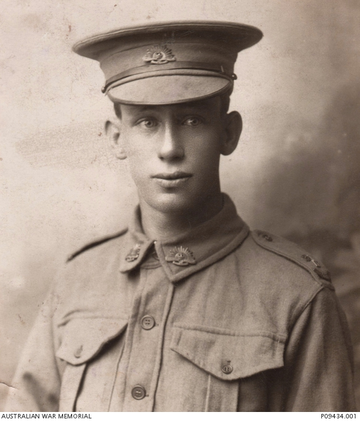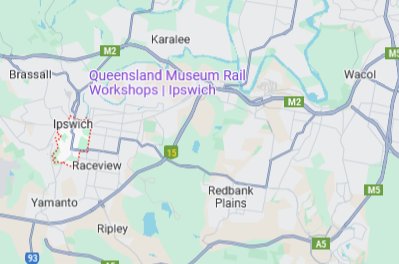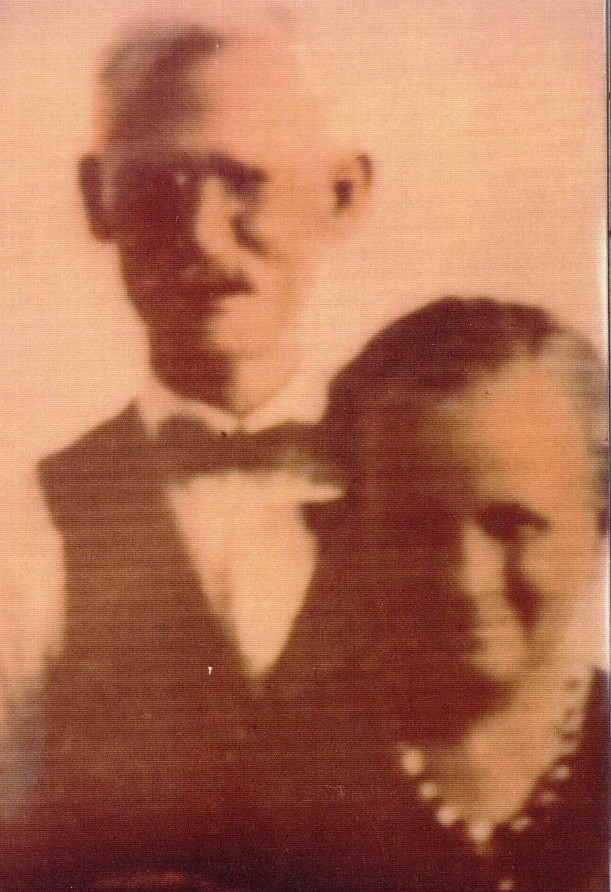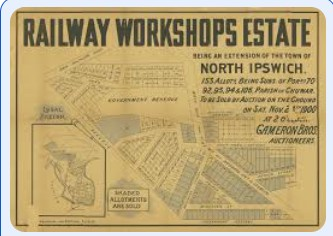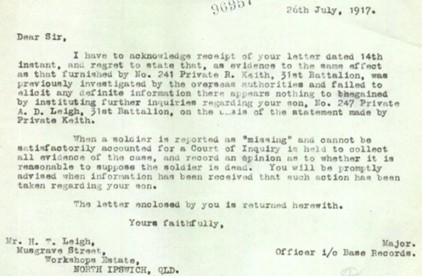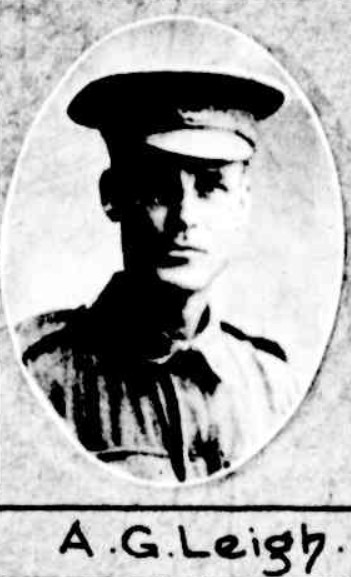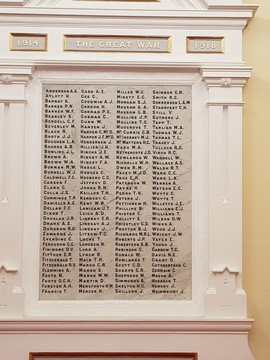Arthur Donald LEIGH
Eyes blue, Hair brown, Complexion fair
Arthur Donald Leigh “A Steady Hand, A Quiet Sacrifice”
Can You Help Us Identify Arthur?
Arthur Donald Leigh was killed in action during the Battle of Fromelles and has no known grave. His name is commemorated on the V.C. Corner Australian Cemetery Memorial, along with over 1,300 other Australians whose bodies were never recovered or identified.
It is believed that Arthur may be among the unidentified soldiers buried by German forces behind Pheasant Wood and reinterred after the war.
Family members have come forward to support the identification effort.
If you believe you are related to Arthur Leigh or the broader Leigh or McNeill families, please contact the Fromelles Association of Australia to discuss participating in the DNA identification project.
Early Life
Arthur Donald Leigh was born in 1893 in Landsborough, Queensland, the first son of Henry Thomas Leigh, 1871-1939 and Elizabeth White McNeill, 1871-1936. He was part of a large family of twelve children, including eldest half-sister Violet:
- Violet McNeil, 1891-1965 m JW Hill
- Arthur Donald , 1893-1916 Fromelles WW1
- Helen , 1894-1973 m WA Gillespie
- Elizabeth, 1895-1896 died infancy
- Hilda May, 1897-1927 no spouse
- Henry, 1899-1950 m Hilda Pedley
- Charles Robert, 1901-1973 m Mary Gilshenan
- Conrad Gerard, 1903-1971 m Evelyn Morrison
- John Hall, 1905-1992 m Elsie Stopford
- Frederick Alan, 1908-1964 m Mary Anderson
- Leah Clements, 1911-1969 m SA Powell
- Edna Mary, 1913-1975 m Donald Callon
Arthur’s early childhood was spent in regional Queensland, but the family eventually settled in North Ipswich, where his father worked with the Queensland Government Railways. Their home on Musgrave Street in the Workshops Estate was located within the tightly woven community of railway families who lived near the locomotive yards.
Arthur’s siblings formed a strong and close-knit household. His eldest sisters, Violet and Helen, helped care for the younger children. His sisters Hilda, Leah, and Edna also remained in the Ipswich area into adulthood. A younger brother, Frederick Leigh, would follow in Arthur’s footsteps in both trade and service — working as a fitter and later enlisting in the Railway Unit in 1917. Another brother, Henry, worked locally and served the community in civilian life. All the Leigh children were raised with a strong work ethic and ties to the local Anglican church, St Thomas’s, where Arthur would remain involved until his departure for war.
Arthur began work at just 15 years old, entering the Queensland Government Railways as a "Learner" in the Locomotive Branch, Southern Division. Over time, he trained and qualified as a fitter, a respected mechanical trade requiring skill, responsibility, and precision. He remained employed in the Ipswich workshops until 1915. Outside of work, Arthur was a keen sportsman. He played football with both the Starlights and Tivoli teams and was known to enjoy swimming. His conduct was described as temperate and respectful, and he was well regarded throughout the North Ipswich community for his character and discipline.
When war was declared, Arthur was 21 years old. None of his brothers were old enough to enlist until Fred did in 1917.
Off to War
Arthur enlisted in Brisbane on 21 July 1915, one of many young tradesmen from Ipswich answering the call to serve. At the time of enlistment, he was 22 years old and working as a qualified fitter in the Queensland Government Railways. He was posted to A Company of the newly formed 31st Battalion, a unit composed of men from Queensland and Victoria. Arthur embarked from Melbourne on 5 November 1915 aboard HMAT A41 Bakara , while other companies of the 31st Battalion sailed a few days later aboard the Wandilla.
After a month-long voyage, Arthur disembarked at Suez, Egypt, on 7 December 1915, where he joined the rest of the battalion at Serapeum for further training and defence duties along the Suez Canal.
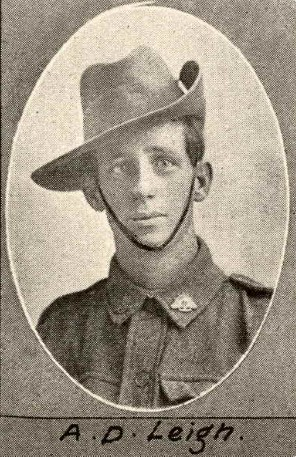
During his time in Egypt, Arthur had a minor disciplinary incident — losing his hat — for which he received 24 hours of Field Punishment No. 2 on 3 June 1916. It was a minor blemish on an otherwise steady record and suggests that the hat was likely lost rather than deliberately discarded. On 16 June 1916, Arthur left Alexandria with his unit, bound for France and the Western Front. He disembarked at Marseilles on 23 June 1916.
Only weeks after arriving in France, Arthur and the men of the 31st Battalion were rushed into their first major engagement — the Battle of Fromelles, on 19–20 July 1916. It was intended as a feint to divert German attention from the Somme, but it became one of the most catastrophic battles in Australian military history.
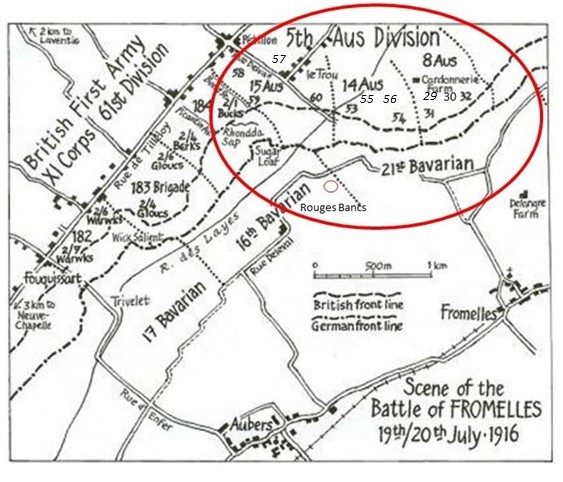
The Battle of Fromelles
After spending several months training in Egypt, the 31st Battalion landed in France in June 1916 and was soon moved into the front lines near the village of Fleurbaix, opposite the strongly fortified German position at Fromelles. The 31st Battalion was part of the 8th Brigade of the newly arrived 5th Australian Division, which was assigned to launch a feint attack to draw German reserves away from the main Somme offensive further south. The original plan was for an attack on 17 July, but bad weather caused it to be postponed. By 4.00 PM on the 19th the men were back in position for the assault.
The attack began at 5.58 PM, with the 31st Battalion advancing in four waves: A and C Companies led in the first two waves, followed by B and D Companies in the third and fourth. The pre-battle bombardment had done significant damage to the German front line, and the 31st made rapid progress, reaching the second line — which in many places was little more than water-filled ditches. Despite the gains, they came under intense and sustained shellfire, not only from the Germans but also from misdirected Allied artillery. By 8.30 PM, the left flank was heavily bombarded with high explosives and shrapnel. Orders came through that:
the trenches were to be held at all costs.
As darkness fell, the situation became increasingly chaotic. German counterattacks intensified, communications broke down, and the Australians were left isolated and running low on ammunition and grenades. Fighting continued through the night. The Australians made another push toward the main German line beyond Trench B, but were running low on grenades. They came under machine gun fire from behind, including from the German strongpoint at Delangre Farm, and were so far advanced they were now being shelled by both sides.
At 4.00 AM, the Germans launched a major counterattack on the Australian left flank, bombing their way into Trench A. Earlier gains had left some Australian support trenches — like Trench E — nearly unoccupied, making it easier for the Germans to surround the isolated forward troops. By 5.30 AM, German bombing parties were attacking from both flanks. With few grenades remaining, the Australians could only resist with rifles.
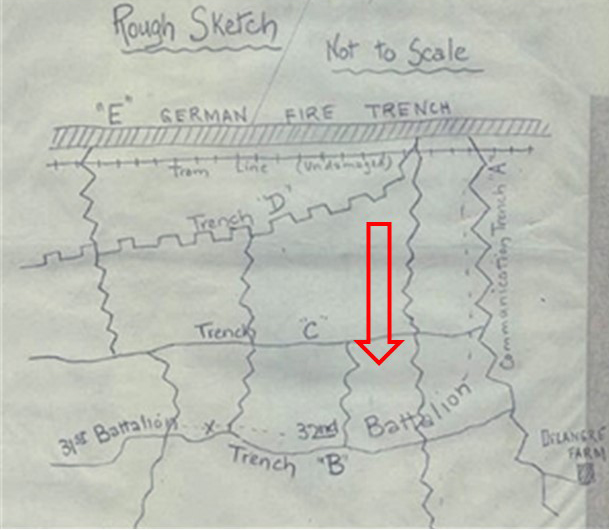
`“The enemy swarmed in and the retirement across No Mans’ Land resembled a shambles, the enemy artillery and machine guns doing deadly damage.”`
Source: AWM4 23/48/12, 31st Battalion War Diaries, July 1916, page 29
By dawn on 20 July, the 31st Battalion was ordered to withdraw. Those who attempted to retreat back across No-Man’s-Land were again cut down by German fire.
Arthur was initially reported missing after the battle. The Red Cross Wounded and Missing file for Arthur Donald Leigh contains two significant witness statements.
Private P.H. Martin (253), 31st Battalion, stated:
“Leigh was struck by a shell in the first line German trenches during our attack at Fromelles on July 19th 1916. We were digging ourselves in at the time, it would have been about 6 p.m. I saw him drop. I believe he was killed instantly, but I was not near enough to him to say for sure.”
Private E.B. Gebbett (1568), 31st Battalion, stated:
“I knew Leigh, he got shot in the leg and was out beyond the German lines and could not get back, in a charge at Fleurbaix in the day of July 20th, 1916.”
A Court of Enquiry held in the field on 1 August 1917 concluded that Arthur had been killed in action on 20 July 1916. A handwritten note on his casualty form states:
“Buried in vicinity of Fleurbaix, Sh.36 N.W.”
However, no grave was ever located or formally identified. The Red Cross later confirmed that there was “No trace Germany. Cert. by Capt. Mills. 10.10.1919.” — meaning his name did not appear on any German death lists, and no information had been recovered from enemy sources.
After the Battle
In the days following the Battle of Fromelles, Arthur Donald Leigh was listed as “missing in action.” Like hundreds of others, his fate was unclear — lost in the confusion of night fighting, artillery fire, and unrelenting machine guns. His parents, Henry and Elizabeth Leigh, were officially notified in mid-August 1916 by the Mayor of Ipswich, Alderman T. J. Smith, who delivered the message in person:
“Last evening the Mayor (Ald. T. J. Smith) received information from the authorities that Pte. A. D. Leigh, a son of Mr H. T. Leigh, Musgrave street, Workshops Estate, North Ipswich, had been missing since the 20th ultimo. He conveyed the message to the missing man’s parents.”
Arthur’s family endured more than a year of uncertainty. His father wrote regularly to the army passing on any information that may have come to the family.
It was not until August 1917 that the military officially confirmed his death:
“Private A. D. Leigh, son of Mr. H. T. Leigh, of North Ipswich, who some time ago was reported to be ‘missing,’ is now officially stated to have been killed in action on July 20, 1916.”
A more detailed tribute followed in the local newspaper:
“The late Pte. Leigh was practically a native of Ipswich … employed up till the time he enlisted … a prominent member of the Starlights and Tivoli football teams … took a keen interest in swimming … of strictly temperate habits and enjoyed the respect of all with whom he was associated … He would have been 21 years of age on August 28.”
The final news of his death was broken to his parents by Mr. P. Read, catechist of St Thomas’s Anglican Church, where the Leigh family worshipped.
Despite the anguish of his loss, the Leigh family continued to serve. Arthur’s younger brother, 1410 Frederick Robert Leigh, enlisted in 1917 and joined the 4th Broad Gauge Railway Operating Company, returning safely in 1919. Arthur’s father Henry was employed by the Commonwealth Government for the British Government for the production of munitions for the War Effort. His uncle, 4164 Arthur Gerard Leigh, also served with the 25th Battalion and was wounded in France.
Arthur’s name is commemorated at:
- V.C. Corner Australian Cemetery Memorial, Fromelles, France
- Australian War Memorial Roll of Honour, Panel 119
- Ipswich Soldiers’ Memorial Hall, Queensland
In 1918, the family published this simple tribute:
“LEIGH.—In loving memory of our dear son and brother, Pte. A. D. Leigh, 31st Battalion, killed in action at Fleurbaix, July 20, 1916.”
Arthur Donald Leigh was 22 years old.
Locating Arthur
Arthur Donald Leigh was killed at Fromelles and has no known grave. Family members have already come forward to support the identification process. DNA testing may help confirm whether Arthur is among the unidentified soldiers reinterred at the Fromelles (Pheasant Wood) Military Cemetery.
If you are a relative and wish to assist, please contact the Fromelles Association of Australia.
DNA samples are being sought for family connections to
| Soldier | Arthur Donald Leigh (1893–1916) |
| Parents | Henry Thomas Leigh (1872–1939) and Elizabeth White McNeil (1871–1936) |
| Siblings | Violet McNeill (1891–1965), m. J.W. Hill (half-sister) | ||
| Helen Leigh (1894–1973), m. W.A. Gillespie | |||
| Elizabeth Leigh (1895–1896) | |||
| Hilda May Leigh (1897–1927) | |||
| Henry Thomas Leigh (1899–1950), m. Hilda Pedley | |||
| Charles Robert Leigh (1901–1973), m. Mary Gilshenan | |||
| Conrad Gerard Leigh (1903–1971), m. Evelyn Morrison | |||
| John Hall Leigh (1905–1992), m. Elsie Stopford | |||
| Frederick Alan Leigh (1908–1964), m. Mary Anderson | |||
| Leah Clements Leigh (1911–1969), m. S.A. Powell | |||
| Edna Mary Mica Leigh (1913–1975), m. Donald Callon |
| Grandparents | ||||
| Paternal | Arthur Leigh (1847–1891) and Leah Clements Hall (1850–1910) | |||
| Maternal | Donald McNeill (1834–1902) and Helen (Ellen) Bannerman (1838–1906) |
Links to Official Records
Seeking DNA Donors

Contacts
(Contact: carla@fromelles.info or geoffrey@fromelles.info).
(Contact: army.uwc@defence.gov.au or phone 1800 019 090).
Donations
If you are able, please contribute to the upkeep of this resource.
(Contact: bill@fromelles.info ).
